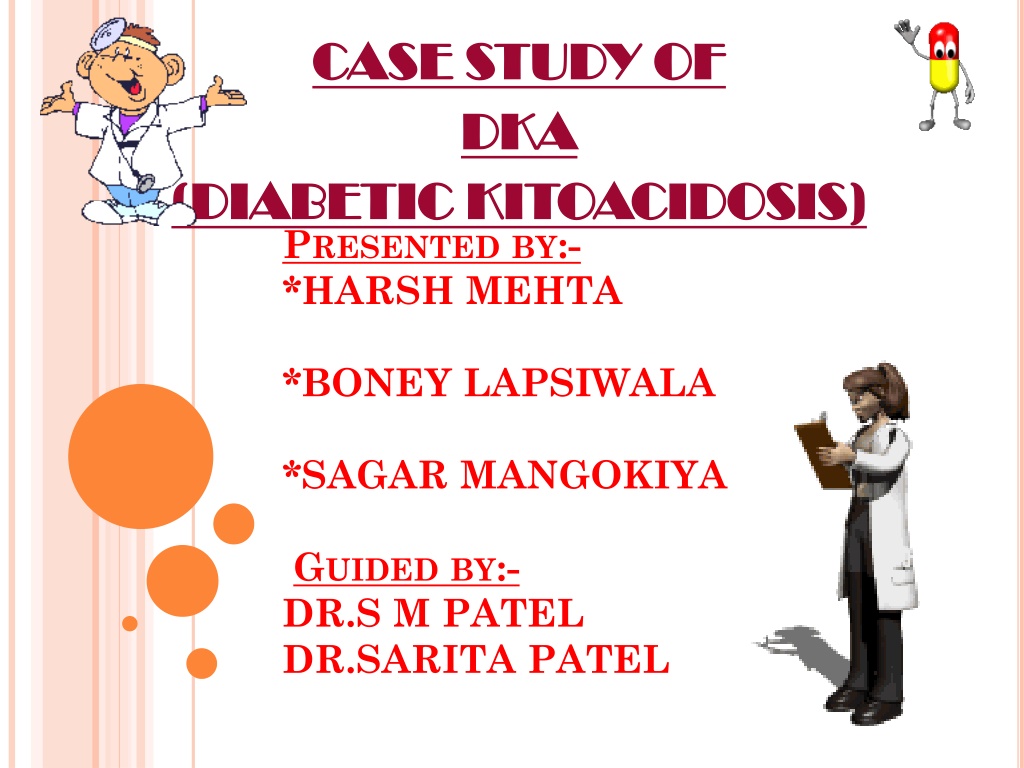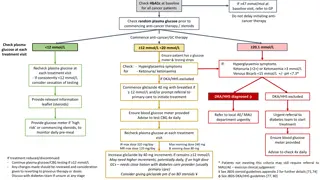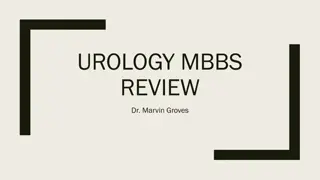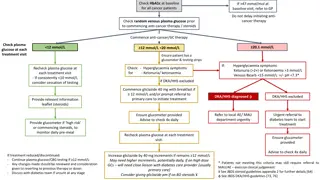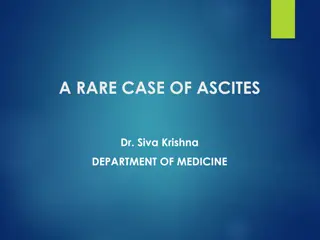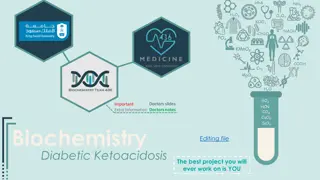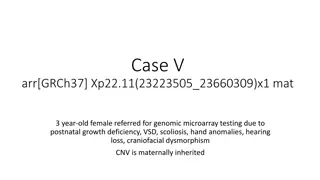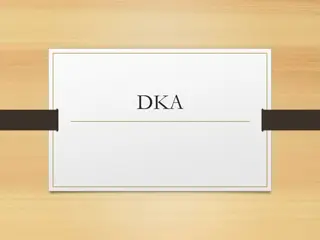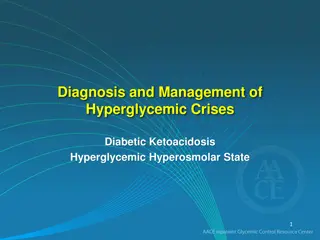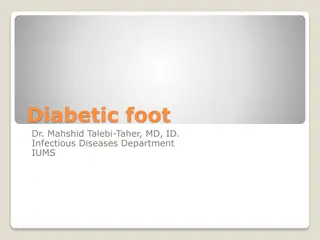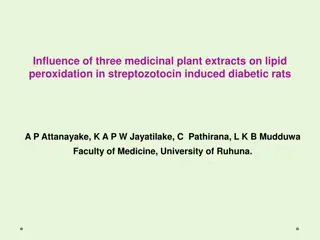Case Study of Diabetic Ketoacidosis (DKA) in a 5-Year-Old Female Patient
A case study on a 5-year-old female patient admitted with symptoms of pain in the right ear, neck, vomiting, and fever. The patient initially sought treatment for ear pain at another hospital before becoming unconscious and being brought to a civil hospital. Biochemistry results revealed abnormalities in albumin, ALT, bilirubin, calcium, creatinine, potassium, and ketones. The case highlights the presentation and management of Diabetic Ketoacidosis (DKA) in a young child.
Uploaded on Oct 01, 2024 | 0 Views
Download Presentation

Please find below an Image/Link to download the presentation.
The content on the website is provided AS IS for your information and personal use only. It may not be sold, licensed, or shared on other websites without obtaining consent from the author. Download presentation by click this link. If you encounter any issues during the download, it is possible that the publisher has removed the file from their server.
E N D
Presentation Transcript
CASE STUDY OF CASE STUDY OF DKA DKA (DIABETIC KITOACIDOSIS) (DIABETIC KITOACIDOSIS) PRESENTED BY:- *HARSH MEHTA *BONEY LAPSIWALA *SAGAR MANGOKIYA GUIDED BY:- DR.S M PATEL DR.SARITA PATEL
Presenting the case of 5 year old female patient admitted in our civil hospital in pediatric ward H-4 dated at 27/09/2016 with following chief complain: Pain in right ear since 15 days Pain in neck since 15 days Vomiting and fever since 15 days
ODP(ORIGIN , DURATION & PROGRESS) Initially patient has complain of pain in the right ear Initially patient has complain of pain in the right ear which got radiated towards the neck region ,and thus they which got radiated towards the neck region ,and thus they went to went to nirmal nirmalhospital with the same chief complain hospital with the same chief complain .This was accompanied by fever and vomiting as what she .This was accompanied by fever and vomiting as what she ate, was vomited out. The medication was taken for ate, was vomited out. The medication was taken for vomiting and it was subsided. For 3 days she was vomiting and it was subsided. For 3 days she was conscious and then she became unconscious and was conscious and then she became unconscious and was brought to civil hospital for further medication. brought to civil hospital for further medication.
Biochemistry section Sample type:Blood(serum,plasma) Date:27/09/2016 Examination(Test) Result Reference Range Albumin 2.9 gm/dL 3.5-5.2 gm/dL ALT 12 U/L <45 U/L Bilirubin Direct 0.1 mg/dL <0.4 mg/gL Bilirubin Total 0.4 mg/dL <1.3 mg/dL Bilirubin Indirect 0.3 mg/dL <1.3 mg/dL Calcium 7.8 mg/dL 8.6-10.2 mg/dL Corrected Calcium 8.6 mg/dL 8.6-10.2 mg/dL Creatinine 1.2 mg/dL 0.8-1.2 mg/dL K+ 5.65 mmol/L 3.5-5.1 mmol/L Ketones Positive N/A Na+ 122.90 mmol/L 136-145 mmol/L
Albumin is synthesized in liver,it decreases in liver and kidney diseases. Albumin:One type of plasma protein.It is water soluble. It Alanine various body tissues but it s more common in liver. Alanine transaminase transaminase(ALT) (ALT): :It is found in plasma and in Bilirubin Bilirubin Total Total: Bilirubin Direct + Bilirubin Indirect
Calcium in plasma are of two types: Calcium : Free form of Calcium. Corrected Calcium: Calcium which attached to Albumin. Free calcium is biologically very important. When albumin is low , albumin bound calcium also decrease,But free calcium remains normal.
Total calcium= free calcium (around 50%)+bound calcium (around 50%) Bound calcium= calcium mostly bound with albumin and also with some other protein. Free Calcium= ionised form in body fluid.It is functional part
Formula: Corrected calcium(mg/dl)= measured total calcium(mg/dl) +0.8 (4.0- Serum albumin(gm/dl)) Where 4 = average albumin level 0.8= Correction factor For every 1 gm/dl drop in serum albumin below 4gm/dl, measured serum total calcium decrease by 0.8mg/dl.
o Creatinine:Its breakdown product of Creatine Phosphate and it is excretery product removed by Kidney.The level of Creatinine determines the functioning of Kidney. o Na+ & K+:They are free ionic minerels which are present in body fluid. o Ketones:Its obtained from catabolism of fat stored in cell when the glucose is not available to cell for energy production.
*Hyperkalemia and potassium deficit in diabetic ketoacidosis: H+-K+ exchange across cell -> hyperkalemia -> Excess loss in urine (deficit with hyperkalemia)
polyuria -> loss of ECF water --> loss of ICF water -> Loss of ICF K+ to maintain ICF K+ -> Hyperkalemia --> Excess loss in urine (deficit with hyperkalemia) polyuria ->low BP --> increased renin --> Aldosterone --> Na+ saved, K+ lost in urine (deficit and pull towards hypokalemia) Insulin promote entry of K+ and Glucose in muscle cell and deficiency cause loss of K+ from ICF
BIOCHEMISTRY SECTION SAMPLETYPE:BLOOD(SERUM,PLASMA) DATE:27/09/2106 Examination(Test) Result Refrence Range Glucose 898 F: 74-100 mg/dL PP: <140 mg/dL R: <200 mg/dL Fasting Post Glucose(75 gm, 2 hours) Diabetes Mellitus >126 Diabetes Mellitus >200 Impaired Fasting Glucose 100-125 Impaired Glucose Tollerence 140-199
Impaired Fasting Glucose: Impaired fasting glucose (IFG) is a type of prediabetes, in which the blood sugar level during fasting is consistently higher than what are considered normal levels however, the level is not high enough to be diagnosed as diabetes mellitus. Impaired Glucose Tollerence: Impaired glucose tolerance (IGT) is a pre-diabetic state. IGT may precede type 2 diabetes mellitus by many years.
COAGULATION PROFILE SAMPLETYPE:BLOOD(SERUM,PLASMA) DATE:27/09/2016 Test Result Refrence Range Prothombine Time Patient 16.00 SEC 11-16 SEC Control 15 SEC
Prothrombin:Prothrombin (coagulation factor II) is proteolytically cleaved to form thrombin in the coagulation cascade, the clotting process. Thrombin in turn acts as a serine protease that converts soluble fibrinogen into insoluble strands of fibrin, as well as catalyzing many other coagulation-related reactions. Prothrombin Time:It indicates the time taken for cloting of blood.(blood plasma)
HAEMOGRAM PROFILE SAMPLE TYPE:BLOOD(SERUM,PLASMA) DATE:27/09/2016 Test Result Refrence Range Blood Counts & Indices Hemoglobin Total RBC Total WBC Platelet Count 7.70 gm% 3.52 mil/cmm 17800 /cmm 310000 /cmm 12-16 gm% 4.2-5.4 mil/cmm 4000-11000 /cmm 1.5-4 lakh /cmm WBC Morphology WBC Platelate on smear Parasites - Adequate Malarial parasite not detcted
ARTERIAL BLOOD GAS ANALYSIS SAMPLETYPE: BLOOD(SERUM,PLASMA) DATE:28/09/2016 UNCOMPASATEDMETABOLICACIDOSIS Test Result Refrence range pH 6.886 7.38-7.42 pCO2 15.8 mmHg 35-45 mmHg pO2 33.6 mmHg 75-100 mmHg
(NIRMAL HOSPITAL) CEREBROSPINAL FLUID(CSF)REPORT SAMPLE:CSFDATE:28/9/2016 PHYSICAL EXAMINATION PROFILE RESULT Quantity 0.5 cc Colour Colourless Odour - Clarity Clear Specific Gravity - Clot Formation -
BIOCHEMISTRY SECTION SAMPLE TYPE:CSF DATE:28/09/2016 EXAMINATION (TEST) RESULT REFERENCE Glucose 669 mg/dL 40-70 mg/dL Total Protein 453 mg/dL 15-40 mg/dL
In CSF fluid- Glucose level is around 60% of serum level. It is higher in this patient due to higher serum glucose level. CSF protein-The main protein in spinal fluid is albumin, a large protein important in the body s fluid balance. During bacterial infection, the level of protein in the spinal fluid goes up, due to an increase in the presence of the replicating bacteria, which have a high composition of protein, and an increase in the number of cells that fight infection and inflammation, which are also composed of protein.
URINE TEST SAMPLE TYPE:URINE DATE:28/09/2016 PROFILE RESULT VALUES Urea 66 mg% 10-45 mg% Creatinine(s) 1.7 mg% 0.5-1.5 mg% Sodium(s) 118 mmol/lit 133-145 mmol/lit Chloride(s) 87 mmol/lit 95-107 mmol/lit Albumin(s) 3 gm% 3.5-5.5 gm% Globulin 2.6 gm% 2.3-4.4 gm% Potassium(s) 2.7 mmol/lit 3.8-5.4 mmol/lit Total Proteins(s) 5.60 gm% 2.3-4.4 gm% A/G Ratio 1.15 0.8-2.0
PERSONALHISTORY Bladder: patient was passing urine at night since month. Bowl: normal Past History:- No significant history Family History: No significant history
DRUG HISTORY: CURRENT MEDICATIONS Drug Allergies No Recent prescription medication Injection ceftriaxome- antibiotic Injection Amikacine Injection Rantac-antacid Injection Vitamin-k Injection Mannitol- diuretics Injection Phenytoin- anticonvulsant
General examination: It was not done Probable Diagnosis: DKA with meningitis. Pateint was expire after the three days of admission in civil hospital.
MENINGITISWITH DKA: The patient is suffering from meningitis along with DKA. Meningitis is inflammation of the thin tissue that surrounds the brain and spinal cord, called the meninges. There are several types of meningitis. The most common is viral meningitis. The patient can get it when a virus enters the body through the nose or mouth and travels to the brain. Bacterial meningitis is rare, but can be deadly.
*DIABETES MELLITUS(DM): This patient may have DM for many months, but undetected. DM decrease body capacity to fight infection Then she may have developed ear infection -> spread to meninges (Covering of brain) --> Meningitis Infection --> release of cortisol by body --> further increase in blood glucose --> worsening of DM
1. Cause of infection DM leads to micro-angiopathy of blood vessels Decrease blood supply Decrease chemotexisis Lead to infection
2. Increase glucose level in Blood which provide good nutritional media for growth of bacteria 3.DM cause Neuropathy which decrease the pain sensation in peripheral parts of the body -> more prone for injury-> poor healing due to less blood supply-> leads to infection
Cause of fever- due to infection Cause of vomitting- meningitis which may lead to increase intracranial pressure - lead to vomiting. Acidosis
QUESTIONS:- What Can be the reason of pain in right ear and neck? What can be the reason of vomitting and fever? What can be the reason of convulsion? What is corrected calcium? What is Glucose tolerance test? What can be the reason of nocturnal urination? What can be the reason of low PH, co2 and low 02? What is the reason of ketone positive report? Example of ketone. What is the reason of high K+ and low sodium in blood?
